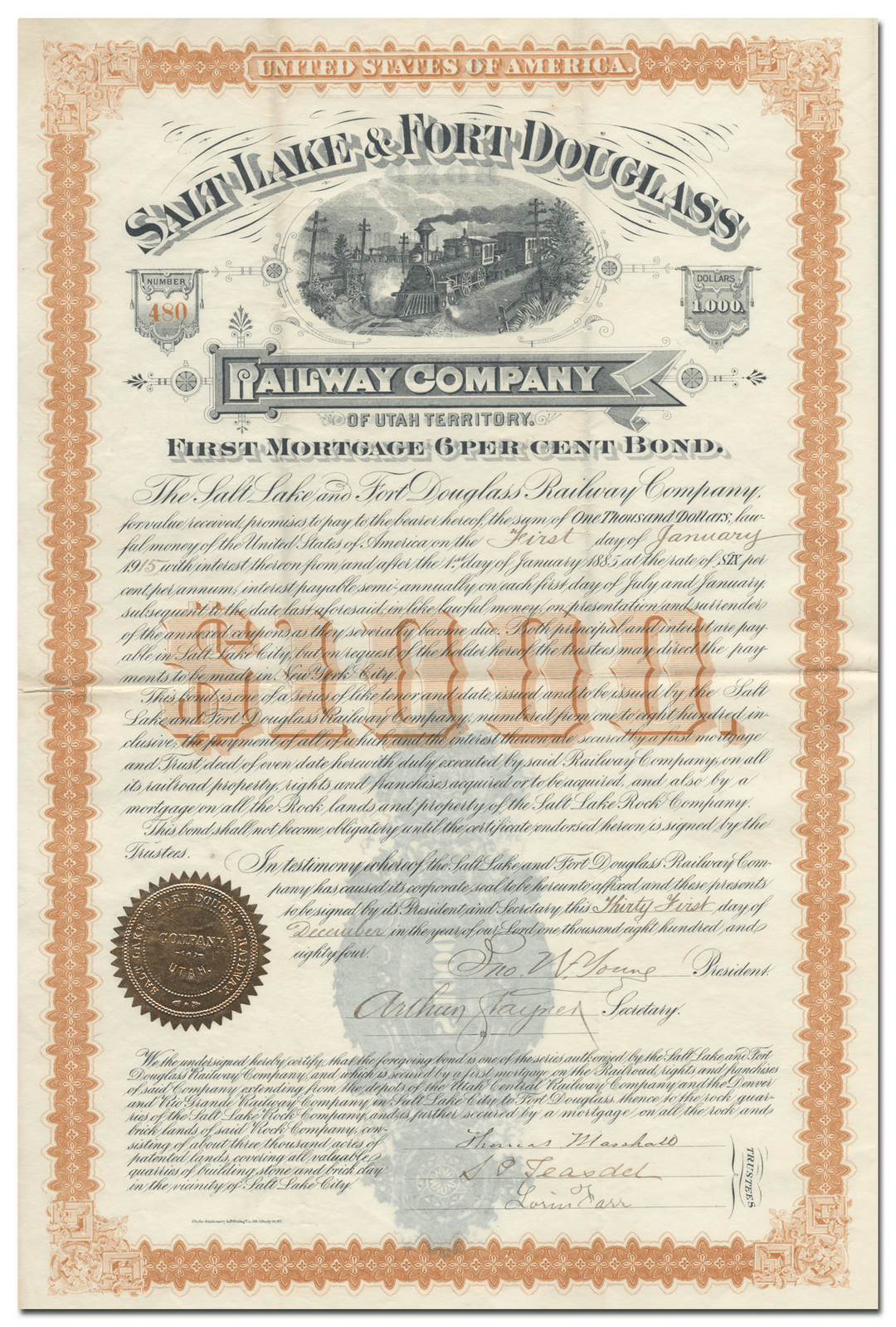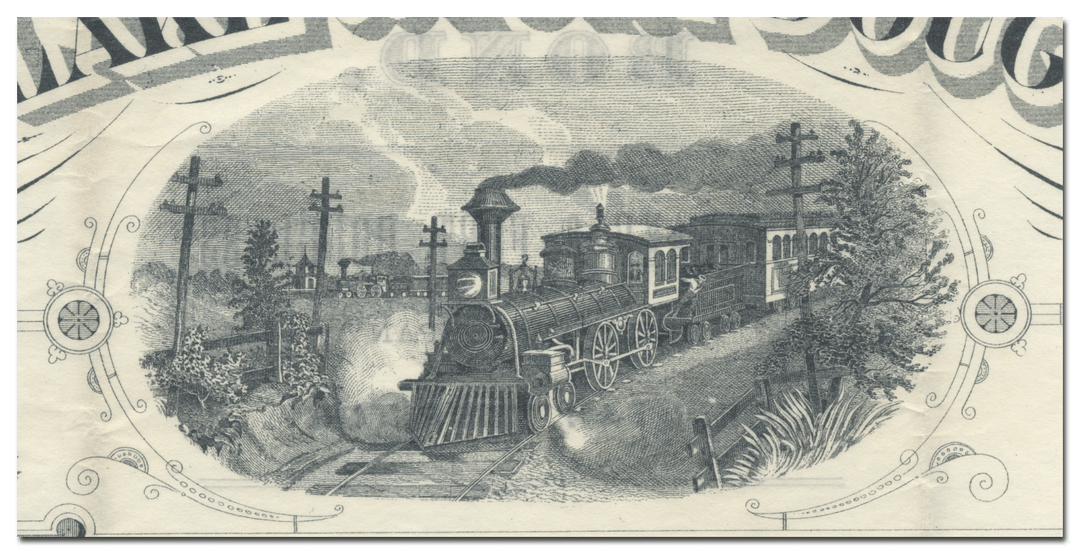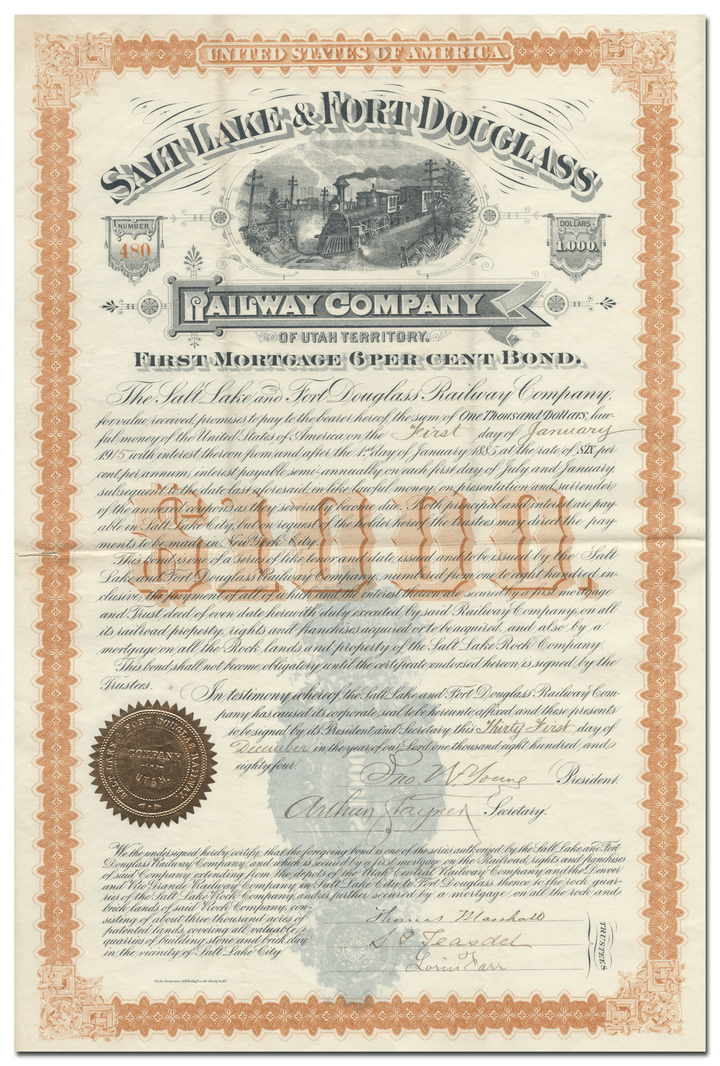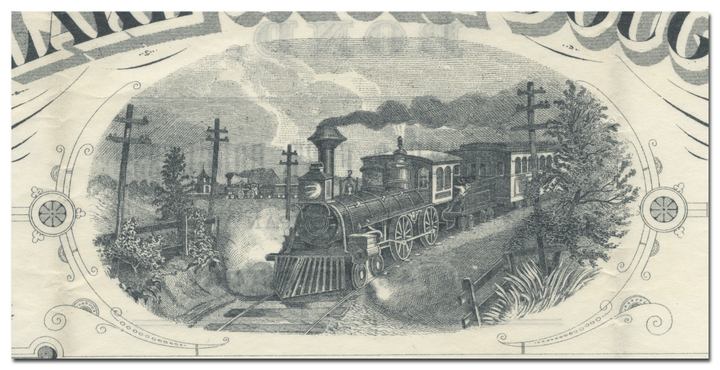Salt Lake & Fort Douglass Railway Company (Signed by John Willard Young)
- Guaranteed authentic document
- Orders over $75 ship FREE to U. S. addresses
Product Details
CompanySalt Lake & Fort Douglass Railway Company
Certificate Type
First Mortgage Bond
Date Issued
December 31, 1884
Canceled
No
Printer
Globe Stationery & Printing Co.
Signatures
Hand signed
Approximate Size
11 3/4" (w) x 18 1/4" (h)
Images
Show the exact certificate you will receive
Guaranteed Authentic
Yes
Additional Details
Signed by John Willard Young, 53 coupons remain attached
Reference
Historical Context
The Salt Lake & Fort Douglass Railway Company was incorporated in the Utah Territories and operated the following lines:
- Main Line: Salt Lake southeast to Park City, 35 miles
- Mill Creek Branch: Johnson's Junction south to Cottonwood, 28 miles
- Fort Douglass Branch: Johnson's Junction south to Wagner, 9 miles
- Red Butte Branch: Fort Douglass south to Red Butte, 7 miles
The lines connected with the Salt Lake & Eastern Railroad.
John Willard Young

John Willard Young's Signature
Young was born in Nauvoo, Illinois to Latter Day Saint apostle Brigham Young and Mary Ann Angell. As a young boy, John traveled with the Mormon pioneers from Illinois to the Salt Lake Valley.
Young was privately ordained an apostle by his father on November 22, 1855, when he was eleven, without a public announcement or adding them to the Quorum of the Twelve Apostles. Young's ordination was reconfirmed on February 4, 1864, when his brothers Brigham Young, Jr. and Joseph Angell Young were ordained apostles by their father. However, none of them became members of the Quorum of the Twelve Apostles upon their ordination because the Quorum already had twelve members. Although Brigham Jr. eventually became a member of the Quorum of the Twelve, John and Joseph never did.
In 1869, Young opened the "Salt Lake City Museum and Menagerie", which was the predecessor of the Deseret Museum. He was also involved with the construction of a railroad in Arizona Territory.
On April 8, 1873, Brigham Young added John, Brigham Jr., George Q. Cannon, Lorenzo Snow, and Albert Carrington as additional counselors to him in the First Presidency. After Young's First Counselor George A. Smith died in September 1875, John Willard Young was called as First Counselor to his father on October 8, 1876. Young served in this capacity until the First Presidency was dissolved by Brigham Young's death less than a year later on August 29, 1877. During his time in the First Presidency, John Willard Young never spent much time in Salt Lake City attending to church leadership duties; since 1863 he had preferred living in New York City, where he was engaged in a number of business ventures that ultimately failed and resulted in him assuming a large amount of debt.
Having never been a member of the Quorum of the Twelve but holding the priesthood office of apostle, Young was called as a counselor to the Quorum of the Twelve Apostles on October 6, 1877. However, Young's business practices and practice of living in New York City soon brought him into conflict with other church authorities. At a general conference of the church on April 6, 1881, Young's name was withheld from the names of general authorities who were presented for "sustaining". Between 1881 and 1885, he was tried before the Quorum of the Twelve on three separate occasions; each time he was reconciled with the Twelve and he retained his position. In 1888, Joseph F. Smith accused Young of unethically using church funds to maintain a lavish lifestyle, and by April 1889 the First Presidency and Quorum of the Twelve were discussing removing Young from his position.
Young resigned from his position on October 3, 1891; Young was aware that on that date the First Presidency and Quorum of the Twelve Apostles were again discussing his possible release from his position. After Young's resignation, he was formally released as a counselor to the Twelve at a conference of the church October 6, 1891.
Although he lived another 33 years, Young never again served as a general authority of the LDS Church, though he remained a church apostle for the rest of his life. On December 9, 1899, apostle Franklin D. Richards died. Richards had been the President of the Quorum of the Twelve Apostles and the second-most senior apostle in the church. Richards's death left Young as the second-most senior apostle in the church. Although Young did not become the President of the Twelve, under the then-existing rules of presidential succession in the church, Young would become the President of the Church when Lorenzo Snow died, since Snow was the only living person who had been ordained an apostle prior to Young. Snow was 85 years old and in poor health, while Young was only 55 years old; it therefore appeared to many that Young would be the next president of the church.
However, many of the general authorities of the church disliked Young and felt that his succession to the presidency would be a disaster for the church. On March 31, 1900, the First Presidency—which consisted of Lorenzo Snow, George Q. Cannon, and Joseph F. Smith—changed the policy of presidential succession. The new president of the church would no longer be the person who had been an ordained apostle the longest; rather, the new president of the church would be the person who had been a member of the Quorum of the Twelve Apostles for the longest period of time. Since Young had never been a member of the Quorum of the Twelve, he could not become the president of the church if Snow died. On April 5, 1900, the First Presidency and the Quorum of the Twelve unanimously approved the new policy.
On October 10, 1901, Snow died. Five days later, Young arrived in Salt Lake City from New York City, possibly with the intent of assuming the presidency of the church. However, due to the new policy, Joseph F. Smith was ordained the new president of the church on October 17, 1901. Young returned to New York City, where he lived for the rest of his life. After he died in New York City, Young was buried at Salt Lake City Cemetery.
After returning to New York City, Young was employed as an elevator operator in an exclusive hotel where he had once lived. In 1902 and 1903, his son Hooper Young was involved in a sensational murder investigation and trial after it was determined that a woman had died in John Willard Young's apartment while he was in France on business. The "Pulitzer Murder" case ultimately resulted in Hooper pleading guilty to second degree murder and being sentenced to life imprisonment in Sing Sing prison. Hooper's conviction had a devastating effect on John Willard, who had initially believed that his son was innocent. John Willard Young continued to attend a branch of the LDS Church in the city for the rest of his life, and he died of cancer in New York City at the age of 79.
Related Collections
Additional Information
Certificates carry no value on any of today's financial indexes and no transfer of ownership is implied. All items offered are collectible in nature only. So, you can frame them, but you can't cash them in!
All of our pieces are original - we do not sell reproductions. If you ever find out that one of our pieces is not authentic, you may return it for a full refund of the purchase price and any associated shipping charges.









